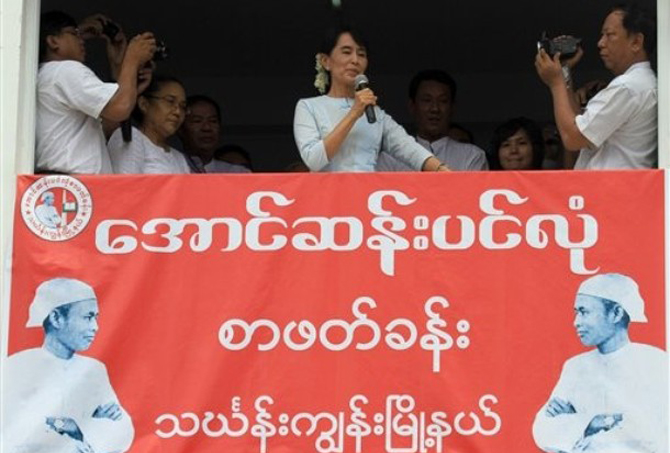The Eye of the Storm

For the last two decades, Snr-Gen Than Shwe’s regime devastated Burma in much the same manner that Cyclone Nargis devastated the Irrawaddy Delta in 2008. The junta’s oppression and mismanagement was a political, economic and human rights disaster for the Burmese people, and the sham election in 2010 gave every indication that the military authoritarianism that has battered the country would not leave anytime soon. But then in August, President Thein Sein invited Aung San Suu Kyi to Naypyidaw for a face-to-face meeting, and the pro-democracy leader seemed to emerge from the conference having discovered the calm at the center of the storm.
The meeting in Naypyidaw appeared to be a spontaneous, home grown initiative that was not sponsored or organized by the UN or any other foreign body, but rather was initiated by Thein Sein and his key supporting players in the new government. It was the first time that Suu Kyi and the new president had met, and they spoke cordially for about an hour and then had dinner together. Burmese state media reported on the meeting and showed video footage and photographs of the two leaders sitting beneath a picture of Suu Kyi’s father, Burma’s independence hero Gen Aung San, who was the founder of the Burmese armed forces.
Suu Kyi was reportedly heartened to see her father’s photo displayed in the offices of the new government, and the tone of the state-run newspaper report of her meeting with Thein Sein was genial and polite, using the Nobel laureate’s full name preceded by “Daw,” a term of respect for Burmese females.
“The president and Daw Aung San Suu Kyi tried to find potential common ground to cooperate in the interests of the nation and the people, putting aside different views,” reported the The New Light of Myanmar.
The news report did not go into any detail about what “potential common grounds” were discussed, but sources say one area of possible agreement was the need to find some acceptable manner for the impoverished nation to receive additional humanitarian assistance from foreign countries and organizations. The two reportedly discussed more contentious issues as well, including political prisoners, the 2008 Constitution, the 1990 election and the legal status of Suu Kyi’s National League for Democracy (NLD).
Some analysts and dissidents opined that the meeting was merely a show meant to persuade the members of the Association of Southeast Asia Nations (Asean) to grant Burma the association’s chair in 2014, the UN to withdraw its call for a Commission of Inquiry into human rights abuses in Burma and Western governments to drop their sanctions. In addition, the role played by Suu Kyi’s long-time nemesis, Than Shwe, is still unclear. It is widely believed that he still pulls the strings with respect to the military and national security, but it’s less certain how involved he remains in domestic political, social and economic matters.
Whether the meeting between Thein Sein and Suu Kyi was a meaningful gesture or merely a publicity stunt undertaken with Than Shwe’s approval, or possibly even direction, remains to be seen. But one thing is certain: the meeting injected a sense of hope into the people of Burma and the international community.
It is notable that Suu Kyi’s body language changed after she met with Thein Sein—a broad smile returned to her face and she seemed more cheerful than prior to the meeting. In addition, her lieutenants, including veteran activist and former political prisoner Win Tin, were more upbeat than before and softened their tone. Despite the lack of specifics to emerge publicly about the meeting, the change in demeanor by both Suu Kyi and her staunchest pro-democracy supporters is a strong indication that the discussions between Suu Kyi and Thein Sein were substantive.
Since Suu Kyi’s visit to Naypyidaw, several other events have occurred that indicate both she and the government are seeking to establish an atmosphere more conducive to exploring the “potential common grounds” the Burmese state media reported on.
First, the government created a National Human Rights Commission, which by its very formation at least acknowledged that human rights are an issue in Burma, although the commission itself is comprised of ambassadors who served under the repressive regime and strongly defended its poor human rights record at the UN and in other international forums. Then to the shock of many, Suu Kyi accepted the invitation of Zaw Zaw—one of Burma’s most powerful tycoons who is close to several regime hard-liners and is on the US sanctions list—to sit next to him at a football match.
1 | 2 | 3 | 4 | 5 | 6 next page »
|
||
|
||
- 'My Wife Died From Police Abuse,' Says Husband
- US Says Observer Conditions Don't Meet Int'l Standards
- 159 Observers to Monitor Burma Election
- Govt to Address Breaches of SSA-South Ceasefire: Aung Min
- Burma Investors Pin Hopes on Seminal Sunday
- Malaysia PM Leads 50-Strong Delegation to Burma
- US Congress to Assess Burma's Political Prisoner Issue
- Rangoon Woman in Police Station Death Plunge
- Burmese Legal System Remains Tool of Govt: AHRC
- Burmese Army Chief Defends Political Role
